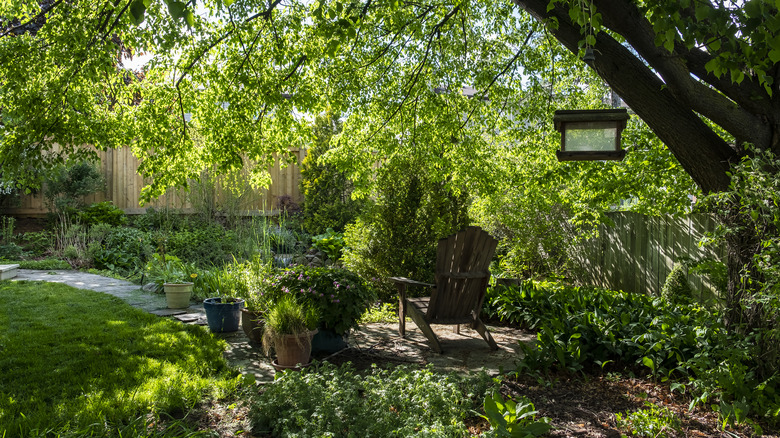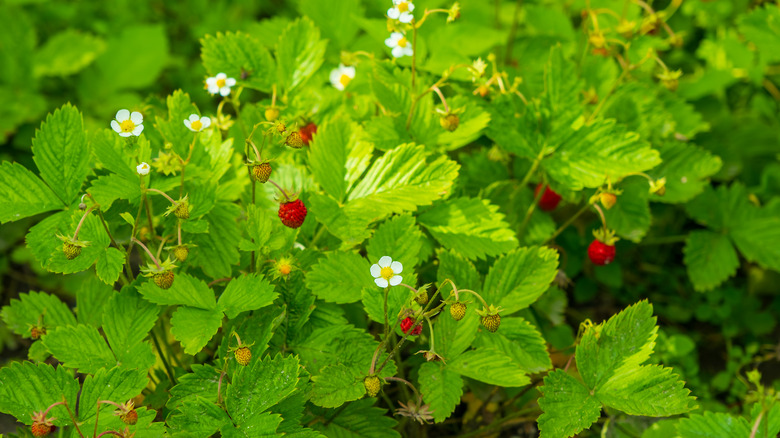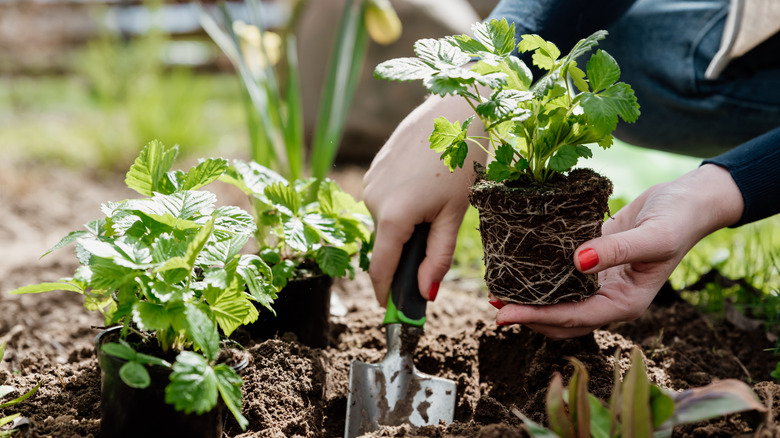The Strawberry Variety That Can Grow In Your Shady Backyard
While your regular strawberry plants might tolerate a little shade, this is far from the secret to a luscious strawberry harvest. Love strawberries but don't have a sunny spot in your beds or on your balcony to grow them? You can still cultivate this natural candy to adorn dessert or that breakfast bowl of granola. You'll just have to be okay with sacrificing the comparatively enormous size of the domesticated strawberry for a strawberry that, while decidedly smaller, packs a punch in terms of flavor. Wild strawberries do well in partial shade and even tolerate deep shade (even if they prefer full sun) — plus, they couldn't be easier to care for.
The moniker "wild strawberry," sometimes also "alpine strawberry" or "wood strawberry," encompasses a bunch of varieties. Fragraria virginiana and Fragraria vesca are the most commonly available and are native to the continental United States, as is the less frequently grown beach strawberry (Fragaria chiloensis). Popular Fragraria vesca cultivars include Alexandra (also "Alexandria"), Semperflorens, Alpine, Baron Solemacher, and Ruegen, and there's also a French-developed wild strawberry called Fragaria Mara des Bois. No matter the cultivar, you can expect to see small, soft, bright pink, deep red, or cream-hued berries between May and July. Sometimes, if you're lucky and conditions are right, they fruit again in the fall! In the wild, these plants grow almost anywhere, from dry sites to damp, full sun to shade, usually at the border of forests or in clearings and meadows.
Wild strawberries as groundcover or rock garden plants
The perfect spot in your garden is pretty much anywhere you want to put them, shady spots included, as long as the soil is rich, damp, and well-draining. They don't do well in drought-like conditions but equally dislike having perpetually wet feet. Meet these requirements, and they're some of the best berries to grow in containers and line pathways as they are to plant in the ground — think woodland-themed beds under a birch stand or crevices in a rock garden, retaining wall, or riverbed. Since wild strawberries only reach a maximum of 7 inches in height and self-seed (if you can manage to leave a few berries un-snacked), the plant makes an excellent groundcover or living mulch for under a stand of trees.
Even the foliage is pretty: the leaves turn red in the fall, adding pumpkin spice season vibes to your garden design. Growing an environmentally supportive garden? Over 60 butterfly species lay their eggs on North America's wild strawberries; ground-nesting bees love to burrow into stands of these plants, and the flowers' button-cute white blooms attract pollinators. Deer, rabbits, and most insect pests aren't interested in these plants, and they are not prone to disease. You might need to use snail and slug treatment at the beginning of the season. The commercial strawberry is, in fact, a hybrid of the wild strawberry, and research into breeding wild strawberries with supermarket varieties to improve yields, flavor, and hardiness continues to this day.
How to get wild strawberries for your garden
Don't take wild strawberries from natural habitats, even if you've noticed tons of feral patches growing well nearby. As mentioned, critters rely on their flowers, fruit, and leaves for food and completing their lifecycle; reducing or disrupting the natural biodiversity of an area is never a good idea. Plus, you might mistake them for the look-alike mock strawberry (Duchesnea indica). Not only do mock strawberry berries have no flavor, but the plant is considered invasive in some parts of the U.S. — it's not something you want to introduce into your garden. You can differentiate the two species when they're in bloom: mock strawberries have yellow flowers, whereas a wild strawberry flower is white. The fruit of the latter is bell-like.
Many wild strawberry varieties propagate through rhizome or root division, making them easy to split up and replant. If you know someone with a thriving backyard patch, ask them if you can dig up some runners for your garden. Otherwise, alpine strawberry seeds and seedlings are relatively easy to find at specialty nurseries. Prepare for spring 2025 planting and pre-order Fragaria virginiana wild strawberry plants from Rare Roots — $13.95 for a 1-quart pot. The Shop at Thomas Jefferson's Monticello sells alpine strawberry plants (Fragaria vesca) in a 2.5-inch pot for $10 each. Get a packet of 100 alpine strawberry seeds (Alexandria variety) for $5.55 from Johnny's Selected Seeds. Live in Hawaii? Fragraria vesca is listed as invasive there.


